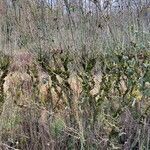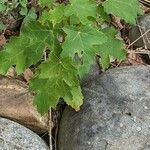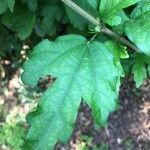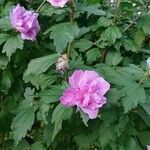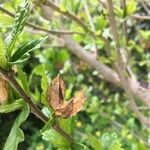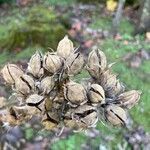Shrubs deciduous, erect, 1.5-4 m tall. Branchlets yellow stellate puberulent. Stipules filiform-subulate, ca. 6 mm, pilose; petiole 5-25 mm, stellate pubescent adaxially; leaf blade rhomboid to triangular-ovate or broadly lanceolate, variously 3-lobed or entire, 3-10 × 2-4 cm, papery, abaxially puberulent along veins or glabrous, adaxially glabrous, basal veins 3-5, base cuneate, margin irregularly incised, apex obtuse to subacute. Flowers solitary, axillary on upper branches. Pedicel 4-14 mm, stellate puberulent. Epicalyx lobes 6-8, filiform, 6-20 × 0.5-2 mm, ± free, connate at base only, densely stellate puberulent, apex obtuse or acute. Calyx campanulate, 14-20 mm, densely stellate puberulent, lobes 5, triangular. Corolla blue-purple, violet, white, pink, or reddish, sometimes with darker center, campanulate, sometimes double, 5-6 cm in diam.; petals obovate, 3.5-4.5 cm, pilose and stellate villous abaxially. Staminal column ca. 3 cm. Style glabrous. Capsule ovoid-globose, ca. 12 mm in diam., densely yellow stellate puberulent. Seeds reniform, with yellow-white hairs abaxially. Fl. Jul-Oct.
Branching shrub to 6 m; lvs ovate in outline, usually 3-lobed, coarsely serrate or dentate, glabrous; cal densely but finely stellate; pet 4–6 cm, white or variously pink, red, blue, or violet; fr prismatic, pointed, densely stellate-tomentose; seeds long-hairy on the margins; 2n=80–92. Native of e. Asia, persistent after cult. and occasionally escaped. July–Sept.
A shrub 3-4 m high. It spreads 1.2-1.8 m wide. It loses its leaves in cooler climates. The leaves are oval with teeth around the edge. They are small and hairless. The flowers are purple with crimson centres. The flowers are bell shaped and can be single or double. They are produced in the axils of leaves. There are a range of cultivated varieties.
